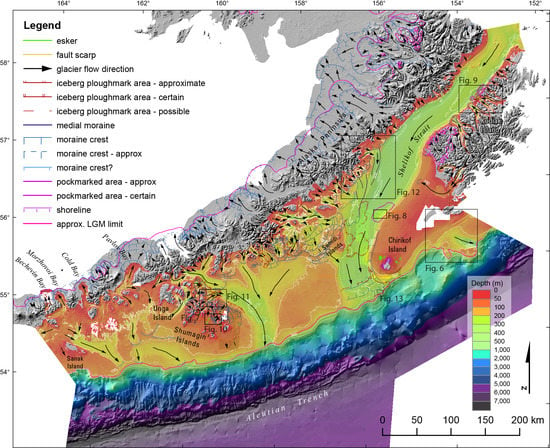Bathymetry and Geomorphology of Shelikof Strait and the Western Gulf of Alaska
Abstract
1. Introduction
1.1. Exploration of the Western Gulf of Alaska and Shelikof Strait
1.2. Bathymetry Compilations
1.3. Biological Research
1.4. Geological Setting
2. Materials and Methods
2.1. Bathymetry Data Sources
2.1.1. Smooth Sheets
2.1.2. Multibeam Surveys
2.1.3. Singlebeam Surveys
2.2. Bathymetry Raster Creation
2.3. Cross-Sections
2.4. Submarine Geomorphology
2.5. Subaerial Geomorphology
3. Results
3.1. Western Gulf of Alaska Bathymetry
3.2. Western Gulf of Alaska Cross Sections
3.3. Categories of Submarine Features
3.3.1. Fault Scarps
3.3.2. Submerged Shorelines
3.3.3. Pockmarks
3.3.4. Glacial Features
4. Discussion
4.1. Improved Bathymetry for Oceanography and Fisheries Research
4.2. Improved Bathymetry for Updating Larger Compilations
4.2.1. Machine versus Human Processing
4.2.2. Unnamed Bank
4.2.3. Shelikof Escarpments
4.3. Glacial Geomorphology
Supplementary Materials
Author Contributions
Acknowledgments
Conflicts of Interest
References
- Frost, O.W. Bering: The Russian Discovery of America, 1st ed.; Yale University Press: New Haven, CT, USA, 2003. [Google Scholar]
- Golder, F.A. Bering’s Voyages, 2nd ed.; Conde Nast Press: New York, NY, USA, 1935. [Google Scholar]
- Postnikov, A.V.; Falk, M.W. Exploring and Mapping Alaska: The Russian American Era, 1741–1867, 1st ed.; Black, L., Translator; University of Alaska Press: Fairbanks, AK, USA, 2015. [Google Scholar]
- Beaglehole, J.C. The Life of Captain James Cook, 1st ed.; Stanford University Press: Stanford, CA, USA, 1974. [Google Scholar]
- McCormick, J. Geographic Dictionary of Alaska, 2nd ed.; US Geological Survey Bulletin: Washington, DC, USA, 1906; Volume 299, p. 690.
- Orth, D.J. Dictionary of Alaska Place Names; Professional Paper 567; US Geological Survey: Washington, DC, USA, 1967; p. 1084.
- Jones, E.L. Safeguard the Gateways of Alaska: Her Waterways; U.S. Department of Commerce, U.S. Coast and Geodetic Survey, Special Publication No. 50; U.S. Government Printing Office: Washington, DC, USA, 1918.
- Belknap, G.E. Deep-Sea Soundings in the North Pacific Ocean Obtained in the United States Steamer Tuscarora; United States Hydrographic Office No. 54; U.S. Government Printing Office: Washington, DC, USA, 1874.
- Tanner, Z.L. Explorations of the Fishing Grounds of Alaska, Washington Territory, and Oregon, During 1888, by the U.S. Fish Commission Steamer Albatross; Bulletin of the United States Fish Commission Volume 8, for 1888; U.S. Government Printing Office: Washington, DC, USA, 1890.
- Zimmermann, M.; Prescott, M.M.; Rooper, C.N. Smooth Sheet Bathymetry of the Aleutian Islands; U.S. Department Commerce: Washington, DC, USA, 2013.
- Zimmermann, M.; Prescott, M.M. Smooth Sheet Bathymetry of Cook Inlet, Alaska; U.S. Department Commerce: Washington, DC, USA, 2014.
- Zimmermann, M.; Prescott, M.M. Smooth Sheet Bathymetry of the Central Gulf of Alaska; U.S. Department Commerce: Washington, DC, USA, 2015.
- Zimmermann, M.; Prescott, M.M. Bathymetry and Canyons of the Eastern Bering Sea. Geosciences 2018, 8, 184. [Google Scholar] [CrossRef]
- Weatherall, P.; Marks, K.M.; Jakobsson, M.; Schmitt, T.; Tani, S.; Arndt, J.E.; Rovere, M.; Chayes, D.; Ferrini, V.; Wigley, R. A new digital bathymetric model of the world’s oceans. Earth Space Sci. 2015, 2, 331–345. [Google Scholar] [CrossRef]
- Smith, W.H.F.; Sandwell, D.T. Global seafloor topography from satellite altimetry and ship depth soundings. Science 1997, 277, 1957–1962. [Google Scholar] [CrossRef]
- Amante, C.; Eakins, B.W. ETOPO1 1 Arc-Minute Global Relief Model: Procedures, Data Sources and Analysis. In NOAA Technical Memorandum ESDIS NGDC-24; NOAA: Silver Spring, MD, USA, 2009. [Google Scholar]
- Danielson, S.L.; Dobbins, E.L.; Jakobsson, M.; Johnson, M.A.; Weingartner, T.J.; Williams, W.J.; Zarayskaya, Y. Sounding the northern seas. Eos 2015, 96. [Google Scholar] [CrossRef]
- Stienessen, S.; McCarthy, A.; Jones, D.T.; Honkalehto, T. Results of the acoustic-trawl surveys of walleye pollock (Gadus chalcogrammus) in the Gulf of Alaska, February-March 2016 (DY2016-02 and DY2016-04). AFSC Processed Report 2017-02, 2017, Alaska Fisheries Science Center, NOAA, National Marine Fisheries Service, 7600 Sand Point Way NE, Seattle WA 98115. Available online: http://www.afsc.noaa.gov/Publications/ProcRpt/PR2017-02.pdf (accessed on 21 September 2019).
- Kendall, A.W.; Piquelle, S.J. Egg and larval distributions of walleye pollock Theragra chalcogramma in Shelikof Strait, Gulf of Alaska. Fish. Bull. USA 1989, 88, 133–154. [Google Scholar]
- Schumacher, J.D.; Kendall, A.W. Some interactions between young walleye pollock and their environment in the wester Gulf of Alaska. CalCOFI Rep. 1991, 32, 22–40. [Google Scholar]
- Courtney, D.L.; Sigler, M.F. Trends in area-weighted CPUE of Pacific sleeper sharks Somniosus pacificus in the northeast Pacific Ocean determined from sablefish longline surveys. Alaska Fish. Res. Bull. 2007, 12, 292–316. [Google Scholar]
- Laman, E.A.; Rooper, C.N.; Turner, K.; Rooney, S.; Cooper, D.; Zimmermann, M. Using species distribution models to define essential fish habitat in Alaska. Can. J. Fish. Aquat. Sci. 2017, 75, 1230–1255. [Google Scholar] [CrossRef]
- Rooney, S.; Rooper, C.N.; Laman, E.A.; Turner, K.; Cooper, D.; Zimmermann, M. Model-Based Essential Fish Habitat Definitions for Gulf of Alaska Groundfish Species; U.S. Department Commerce: Washington, DC, USA, 2018.
- Turner, K.; Rooper, C.N.; Laman, E.A.; Rooney, S.C.; Cooper, D.W.; Zimmermann, M. Model-Based Essential Fish Habitat Definitions for Aleutian Island Groundfish Species; U.S. Department Commerce: Washington, DC, USA, 2017.
- Laman, E.A.; Rooper, C.N.; Rooney, S.C.; Turner, K.A.; Cooper, D.W.; Zimmermann, M. Model-Based Essential Fish Habitat Definitions for Bering Sea Groundfish Species; U.S. Department Commerce: Washington, DC, USA, 2017.
- Zimmermann, M.; Reid, J.A.; Golden, N. Using smooth sheets to describe groundfish habitat in Alaskan waters. Deep Sea Res. II Top. Stud. Oceanogr. 2016, 132, 210–226. [Google Scholar] [CrossRef]
- Zimmermann, M. Comparison of the physical attributes of the central and eastern Gulf of Alaska IERP inshore study sites. Deep Sea Res. II Top. Stud. Oceanogr. 2019, 165, 280–291. [Google Scholar] [CrossRef]
- Zimmermann, M.; De Robertis, A.; Ormseth, O. Verification of historical smooth sheet bathymetry. Deep Sea Res. II Top. Stud. Oceanogr. 2019, 165, 292–302. [Google Scholar] [CrossRef]
- Pirtle, J.; Shotwell, S.K.; Zimmermann, M.; Reid, J.A.; Golden, N. Habitat Suitability Models for Groundfish in the Gulf of Alaska. Deep Sea Res. II Top. Stud. Oceanogr. 2019, 165, 303–321. [Google Scholar] [CrossRef]
- McGowan, D.W.; Horne, J.K.; Thorson, J.T.; Zimmermann, M. Influence of environmental factors on capelin distributions in the Gulf of Alaska. Deep Sea Res. II Top. Stud. Oceanogr. 2019, 165, 238–254. [Google Scholar] [CrossRef]
- Mordy, C.W.; Stabeno, P.J.; Kachel, N.B.; Kachel, D.; Ladd, C.; Zimmermann, M.; Doyle, M. Importance of canyons to the northern gulf of Alaska ecosystem. Deep Sea Res. II Top. Stud. Oceanogr. 2019, 165, 203–220. [Google Scholar] [CrossRef]
- Zimmermann, M.; Ruggerone, G.T.; Freymueller, J.T.; Kinsman, N.; Ward, D.H.; Hogrefe, K. Volcanic ash deposition, eelgrass beds, and inshore habitat loss from the 1920s to the 1990s at Chignik, Alaska. Estuar. Coast. Shelf Sci. 2018, 202, 69–86. [Google Scholar] [CrossRef]
- Rooper, C.N.; Zimmermann, M.; Prescott, M.M.; Hermann, A.J. Predictive models of coral and sponge distribution, abundance and diversity in bottom trawl surveys of the Aleutian Islands, Alaska. Mar. Ecol. Prog. Ser. 2014, 503, 157–176. [Google Scholar] [CrossRef]
- Rooper, C.N.; Zimmermann, M.; Prescott, M.M. Comparison of modeling methods to predict the spatial distribution of deep-sea coral and sponge in the Gulf of Alaska. Deep Sea Res. Part I Oceanogr. Res. Pap. 2017, 126, 148–161. [Google Scholar] [CrossRef]
- Plafker, G.; Moore, J.C.; Winkler, G.R. Geology of the Southern Alaska Margin; Plafker, G., Berg, H.C., Eds.; Geological Society of America: Boulder, CO, USA, 1994; Volume G-1, pp. 389–449. [Google Scholar]
- Coulter, H.W.; Hopkins, D.M.; Karlstrom, T.N.V.; Péwé, T.L.; Wahrhaftig, C.; Williams, J.R. Map Showing Extent of glaciations in Alaska; U.S. Geological Survey Miscellaneous Geologic Investigations Map, I-415; U.S. Geological Survey: Reston, VA, USA, 1965.
- Hamilton, T.D. Late Cenozoic Glaciation of Alaska; Plafker, G., Berg, H.C., Eds.; Geological Society of America: Boulder, CO, USA, 1994; Volume G-1, pp. 813–844. [Google Scholar]
- Kaufman, D.S.; Manley, W.F. Pleistocene Maximum and Late Wisconsinan glacier extents across Alaska, USA. In Quaternary Glaciations—Extent and Chronology, Part II: North America. Developments in Quaternary Science; Ehlers, J., Gibbard, P.L., Eds.; Elsevier: Amsterdam, The Netherlands, 2004; Volume 2B, pp. 9–27. [Google Scholar]
- Misarti, N.; Finney, B.P.; Jordan, J.W.; Maschner, H.D.G.; Addison, J.A.; Shapley, M.D.; Krumhardt, A.; Beget, J.E. Early retreat of the Alaska Peninsula Glacier Complex and the implications for coastal migrations of first Americans. Quat. Sci. Rev. 2012, 48, 1–6. [Google Scholar] [CrossRef]
- Mann, D.H.; Peteet, D.M. Extent and timing of the last glacial maximum in southwest Alaska. Quat. Res. 1994, 42, 136–148. [Google Scholar] [CrossRef]
- Briner, J.P.; Tulenko, J.P.; Kaufman, D.S.; Young, N.E.; Baichtal, J.F.; Lesnek, A. The last deglaciation of Alaska. Cuad. Investig. Geogr. 2017, 43, 429–448. [Google Scholar] [CrossRef][Green Version]
- Detterman, R.L.; Miller, T.P.; Yount, M.E.; Wilson, F.H. Quaternary Geologic Map of the Chignik and Sutwik Island Quadrangles, Alaska; U.S. Geological Survey Miscellaneous Investigation Series Map I-1229, scale: 1:250,000, 1 sheet; U.S. Geological Survey: Reston, VA, USA, 1981.
- Detterman, R.L.; Wilson, F.H.; Young, M.E.; Miller, T.P. Quaternary Geologic Map of the Ugashik, Bristol Bay, and Western Part of Karluk Quadrangles, Alaska; U.S. Geological Survey Miscellaneous Investigation Series Map I-1801, scale: 1:250,000; U.S. Geological Survey: Reston, VA, USA, 1987.
- Wilson, F.H.; Detterman, R.L.; Miller, J.W.; Case, J.E. Geologic Map of the Port Moller, Stepovak Bay, and Simeonof Island Quadrangles, Alaska Peninsula, Alaska; U.S. Geological Survey Miscellaneous Investigation Series Map I-2272, scale: 1:250,000, 2 sheets; U.S. Geological Survey: Reston, VA, USA, 1995.
- Wilson, F.H.; Weber, F.R.; Dochat, T.M.; Miller, T.P.; Detterman, R.L. Revised Geologic Map of the Cold Bay and False Pass Quadrangles, Alaska Peninsula; U.S. Geological Survey Open-File Report 97-866, scale: 1:250,000, 1 sheet; U.S. Geological Survey: Reston, VA, USA, 1997.
- Kaufman, D.S.; Young, N.E.; Briner, J.P.; Manley, W.F. Alaska palaeo-glacier atlas (version 2). Dev. Quat. Sci. 2011, 15, 427–445. [Google Scholar] [CrossRef]
- Clark, P.U.; Dyke, A.S.; Shakun, J.D.; Carlson, A.E.; Clark, J.; Wohlfarth, B.; Mitrovica, J.X.; Hostetler, S.W.; McCabe, A.M. The last glacial maximum. Science 2009, 325, 710–714. [Google Scholar] [CrossRef]
- Prescott, M.M.; Zimmermann, M. Smooth Sheet Bathymetry of Norton Sound; U.S. Department Commerce: Washington, DC, USA, 2015.
- Barry, C.; Legeer, S.; Parker, G.; VanSant, K.U.S. Office of Coast Survey’s Re-Engineered Process for Application of Hydrographic Survey Data to NOAA Charts. 2005. Available online: http://www.nauticalcharts.noaa.gov/hsd/docs/SW_techpaper_barry.pdf (accessed on 21 September 2019).
- Zimmermann, M.; Benson, J. Smooth Sheets: How to Work with Them in a GIS to Derive Bathymetry, Features and Substrates; U.S. Department Commerce: Washington, DC, USA, 2013.
- Hampton, M.A. Quaternary sedimentation in Shelikof Strait, Alaska. Mar. Geol. 1985, 62, 213–253. [Google Scholar] [CrossRef]
- Von Huene, R.; Hampton, M.A.; Fisher, M.A.; Varchol, D.J.; Cochrane, G.R. Map Showing Near-Surface Geologic Structures of Kodiak Shelf, Alaska; U.S. Geological Survey Miscellaneous Field Studies Map 1200, 1 sheet, scale: 1:500,000; U.S. Geological Survey: Reston, VA, USA, 1980.
- Carver, G.; Sauber, J.; Lettis, W.; Witter, R.; Whitney, B.; Freymueller, J.T. Active faults on northeastern Kodiak Island, Alaska. Act. Tecton. Seism. Potential Alask. Am. Geophys. Union Geophys. Monogr. 2008, 179, 167–184. [Google Scholar]
- Ramos, M.D. Earthquake Segment Boundaries and Tsunamigenic Faults of the Kodiak Segment, Alaska-Aleutian Subduction Zone. Master’s Thesis, Boise State University, Boise, ID, USA, 2017. [Google Scholar]
- Berndt, C. Focused fluid flow in passive continental margins. Philos. Trans. R. Soc. A 2005, 363, 2855–2871. [Google Scholar] [CrossRef]
- Judd, A.G.; Hovland, M. Seabed Fluid Flow: The Impact of Geology, Biology and the Marine Environment; Cambridge University Press: Cambridge, UK, 2007; Volume 15, p. 475. [Google Scholar]
- Newman, K.R.; Cormier, M.H.; Weissel, J.K.; Driscoll, N.W.; Kastner, M.; Solomon, E.A.; Robertson, G.; Hill, J.C.; Singh, H.; Camilli, R.; et al. Active methane venting observed at giant pockmarks along the US mid-Atlantic shelf break. Earth Planet. Sci. Lett. 2008, 267, 341–352. [Google Scholar] [CrossRef]
- Bøe, R.; Rise, L.; Ottesen, D. Elongate depressions on the southern slope of the Norwegian Trench (Skagerrak): Morphology and evolution. Mar. Geol. 1998, 146, 191–203. [Google Scholar] [CrossRef]
- Dowdeswell, J.A.; Canals, M.; Jakobsson, M.; Todd, B.J.; Dowdeswell, E.K.; Hogan, K. (Eds.) Atlas of Submarine Glacial Landforms: Modern, Quaternary and Ancient; Geological Society of London: London, UK, 2016; p. 618. [Google Scholar]
- Ottesen, D.; Dowdeswell, J.A. Assemblages of submarine landforms produced by tidewater glaciers in Svalbard. J. Geophys. Res. Earth Surf. 2006, 111. [Google Scholar] [CrossRef]
- Ottesen, D.; Dowdeswell, J.A.; Benn, D.I.; Kristensen, L.; Christiansen, H.H.; Christensen, O.; Hansen, L.; Lebesbye, E.; Forwick, M.; Vorren, T.O. Submarine landforms characteristic of glacier surges in two Spitsbergen fjords. Quat. Sci. Rev. 2008, 27, 1583–1599. [Google Scholar] [CrossRef]
- Brown, C.S.; Newton, A.M.; Huuse, M.; Buckley, F. Iceberg scours, pits, and pockmarks in the North Falkland Basin. Mar. Geol. 2017, 386, 140–152. [Google Scholar] [CrossRef]
- López-Martínez, J.; Muñoz, A.; Dowdeswell, J.A.; Linés, C.; Acosta, J. Relict sea-floor ploughmarks record deep-keeled Antarctic icebergs to 45 S on the Argentine margin. Mar. Geol. 2011, 288, 43–48. [Google Scholar] [CrossRef]
- Syvitski, J.P.M.; Stein, A.B.; Andrews, J.T.; Milliman, J.D. Icebergs and the sea floor of the East Greenland (Kangerlussuaq) continental margin. Arct. Antarct. Alp. Res. 2001, 33, 52. [Google Scholar] [CrossRef]
- Fairbanks, R.G. A 17,000-year glacio-eustatic sea level record: Influence of glacial melting rates on the Younger Dryas event and deep-ocean circulation. Nature 1989, 342, 637–642. [Google Scholar] [CrossRef]
- Food and Agriculture Organization. The state of world fisheries and aquaculture 2016. In Contributing to Food Security and Nutrition for All; FAO: Rome, Italy, 2016. [Google Scholar]
- Schumacher, J.D.; Stabeno, P.J.; Roach, A.T. Volume transport in the Alaska Coastal Current. Cont. Shel. Res. 1989, 9, 1071–1083. [Google Scholar] [CrossRef]
- Reed, R.K.; Schumacher, J.D.; Incze, L.S. Circulation in Shelikof Strait, Alaska. J. Phys. Oceanogr. 1987, 17, 1546–1554. [Google Scholar] [CrossRef]
- Bograd, S.J.; Stabeno, P.J.; Schumacher, J.D. A census of mesoscale eddies in Shelikof Strait. J. Geophys. Res. 1994, 99, 18243–18254. [Google Scholar] [CrossRef]
- Schumacher, J.D.; Stabeno, P.J.; Bograd, S.J. Characteristics of an eddy over a continental shelf: Shelikof Strait, Alaska. J. Geophys. Res. 1993, 98, 8395–8404. [Google Scholar] [CrossRef]
- Bacheler, N.M.; Bailey, K.M.; Ciannelli, L.; Bartolino, V.; Chan, K.S. Density-dependent, landscape, and climate effects on spawning distribution of walleye pollock Theragra chalcogramma. Mar. Ecol. Prog. Ser. 2009, 391, 1–12. [Google Scholar] [CrossRef]
- Schumacher, J.D.; Reed, R.K. Coastal flow in the northwest Gulf of Alaska: The Kenai current. J. Geophys. Res. 1980, 85, 6680–6688. [Google Scholar] [CrossRef]
- Hart, J.L. Pacific Fishes of Canada; Bulletin 180; Fisheries Research Board of Canada: Ottawa, ON, Canada, 1975. [Google Scholar]
- Tribuzio, C.A.; Hulson, P.-J.; Echave, K.; Rodgveller, C. Assessment of the shark stock complex in the Gulf of Alaska. In Stock Assessment and Fishery Evaluation Report for the Groundfish Resources of the Gulf of Alaska; North Pacific Fishery Management Council: Anchorage, AK, USA, 2017; pp. 1343–1346. [Google Scholar]
- Mayer, L.; Jakobsson, M.; Allen, G.; Dorschel, B.; Falconer, R.; Ferrini, V.; Lamarche, G.; Snaith, H.; Weatherall, P. The Nippon Foundation—GEBCO seabed 2030 project: The quest to see the world’s oceans completely mapped by 2030. Geosciences 2018, 8, 63. [Google Scholar] [CrossRef]
- NOAA. 2-minute Gridded Global Relief Data (ETOPO2) v2. 2006. Available online: https://data.nodc.noaa.gov/cgi-bin/iso?id=gov.noaa.ngdc.mgg.dem:301 (accessed on 10 April 2018).
- Brothers, D.S.; Haeussler, P.; East, A.; ten Brink, U.; Andrews, B.; Dartnell, P.; Miller, N.; Kluesner, J. A closer look at an undersea source of Alaskan earthquakes. EOS 2018, 99, 22–26. [Google Scholar] [CrossRef]
- Batchelor, C.L.; Dowdeswell, J.A. The physiography of high Arctic cross-shelf troughs. Quat. Sci. Rev. 2014, 92, 68–96. [Google Scholar] [CrossRef]
- Karlstrom, T.N.V. Upper Cook Inlet region, Alaska, in Multiple Glaciation in Alaska: U.S. Geol. Surv. Circ. 1953, 289, 1–13. [Google Scholar]
- Hajdas, I.; Bonani, G.; Bodén, P.; Peteet, D.M.; Mann, D.H. Cold reversal on Kodiak Island, Alaska, correlated with the European Younger Dryas by using variations of atmospheric 14C content. Geology 1998, 26, 1047–1050. [Google Scholar] [CrossRef]
- Briner, J.P.; Kaufman, D.S.; Werner, A.; Caffee, M.; Levy, L.; Manley, W.F.; Kaplan, M.R.; Finkel, R.C. Glacier readvance during the late glacial (Younger Dryas?) in the Ahklun Mountains, southwestern Alaska. Geology 2002, 30, 679–682. [Google Scholar] [CrossRef]
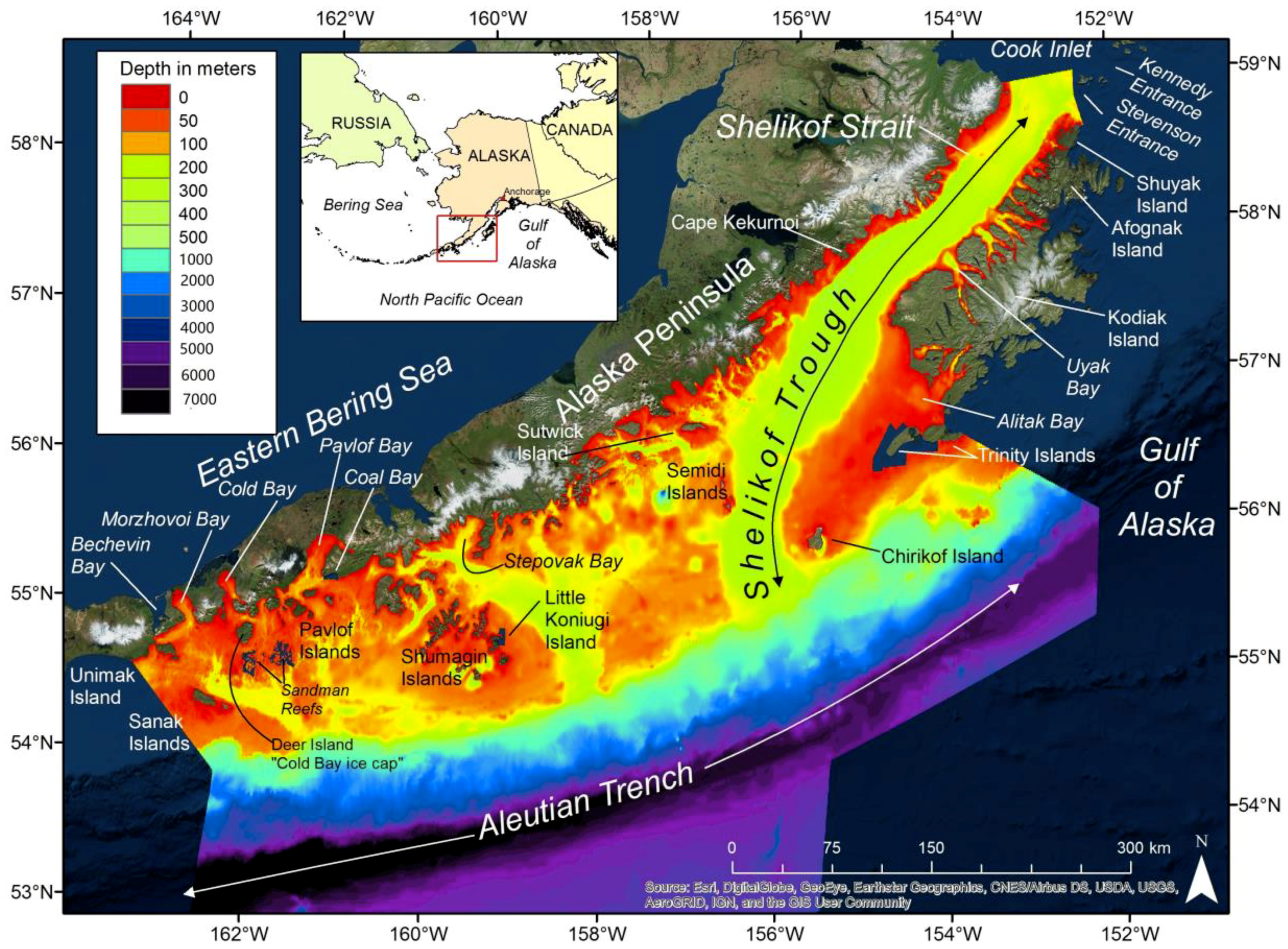
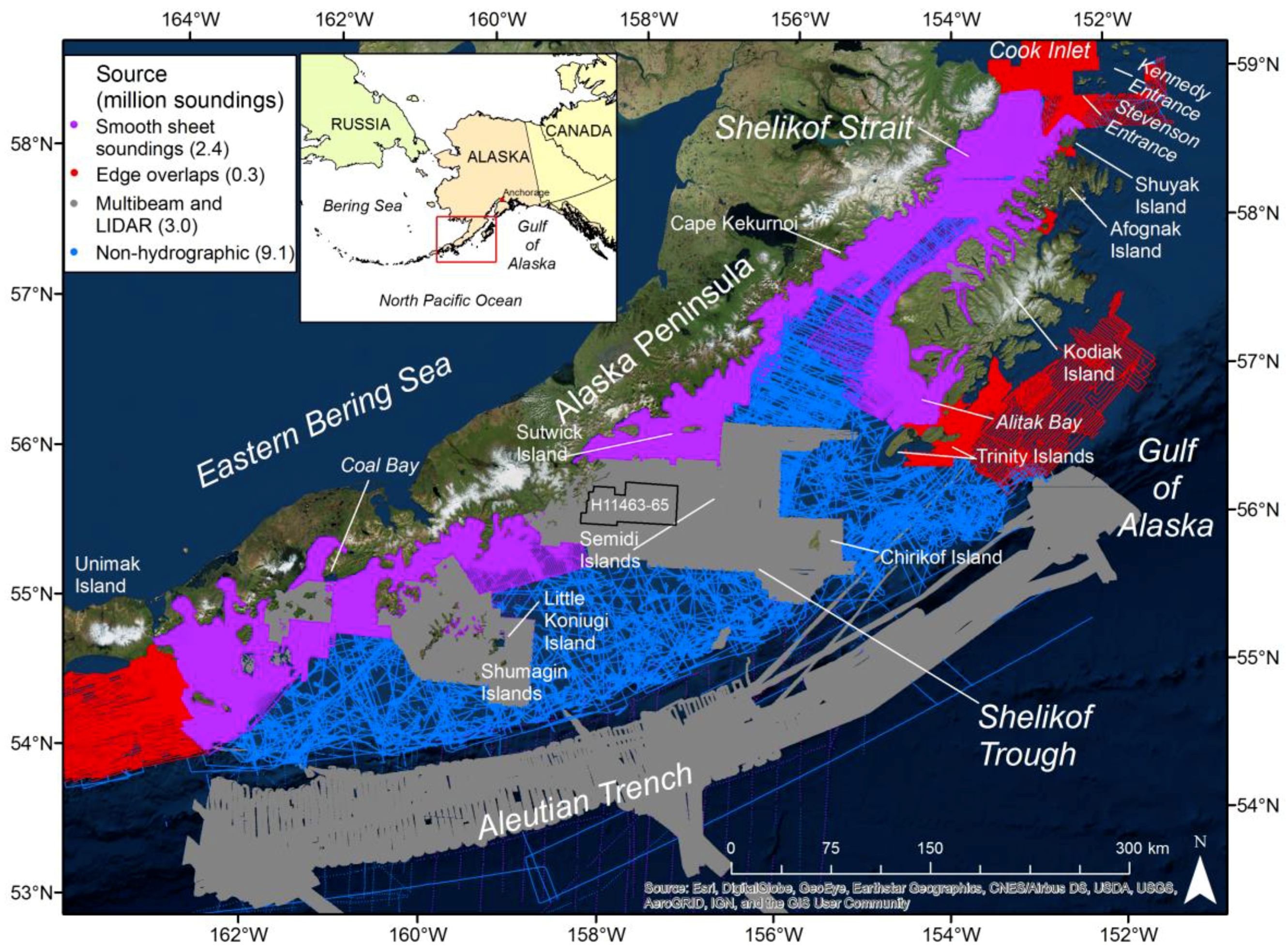
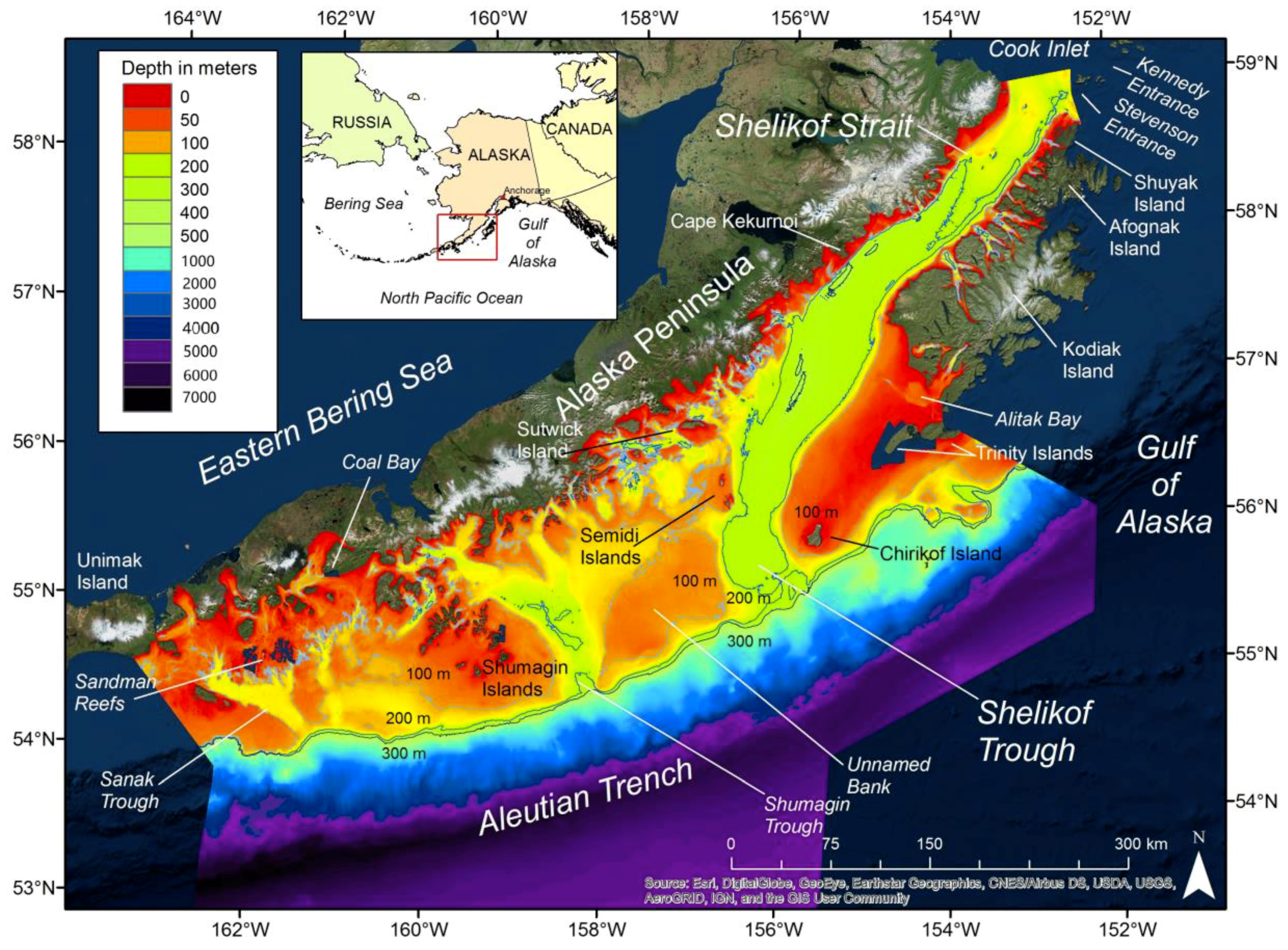
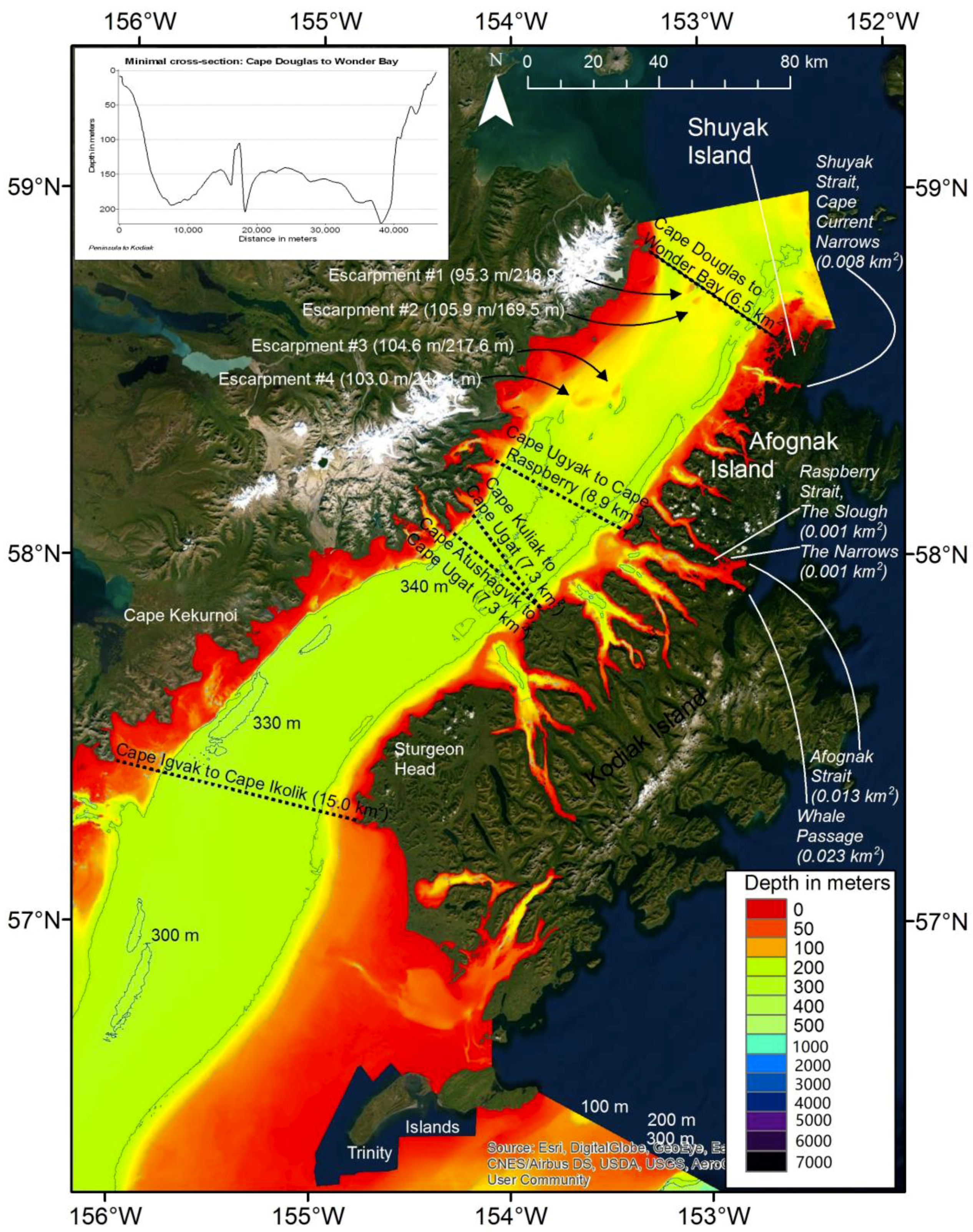
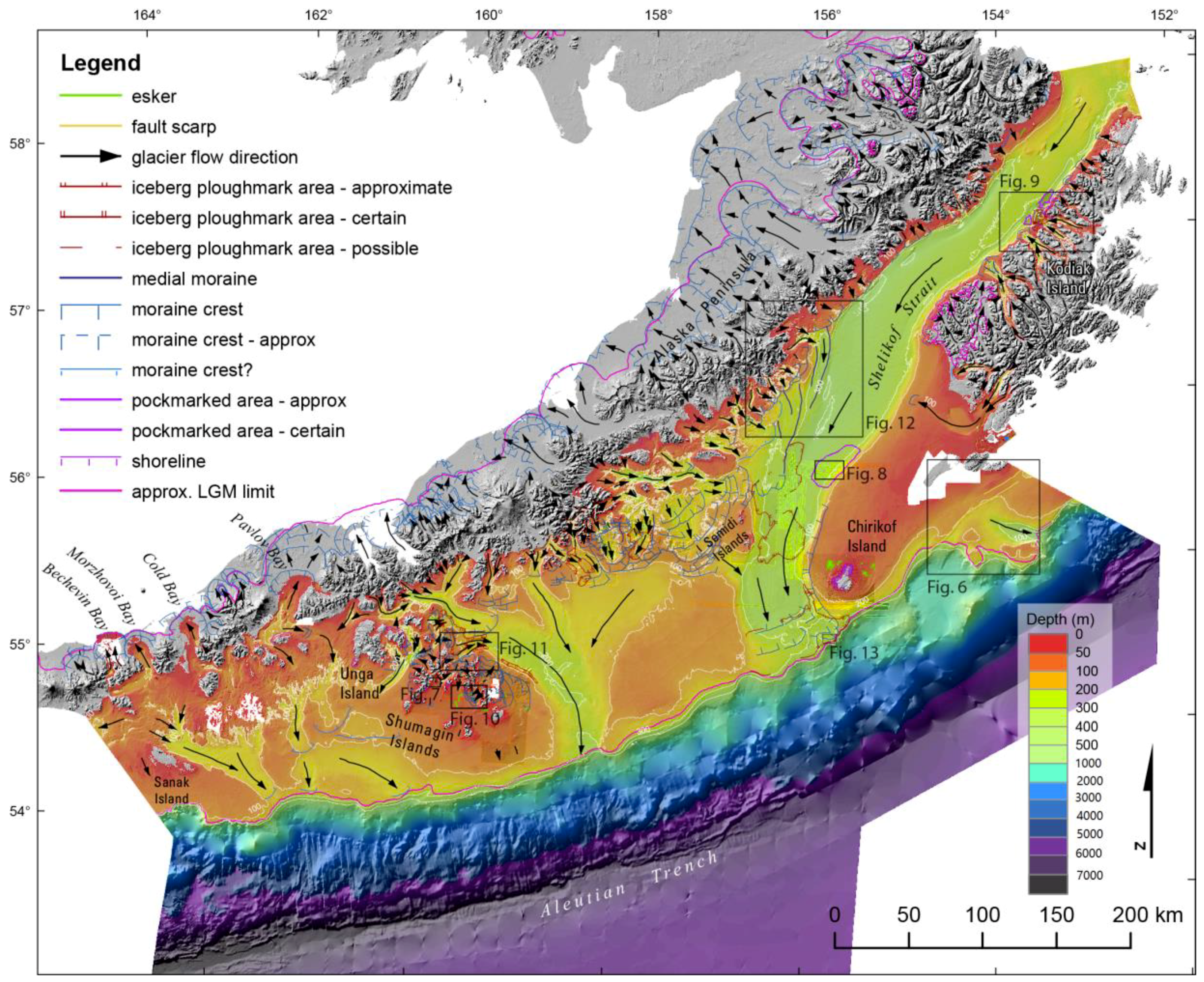
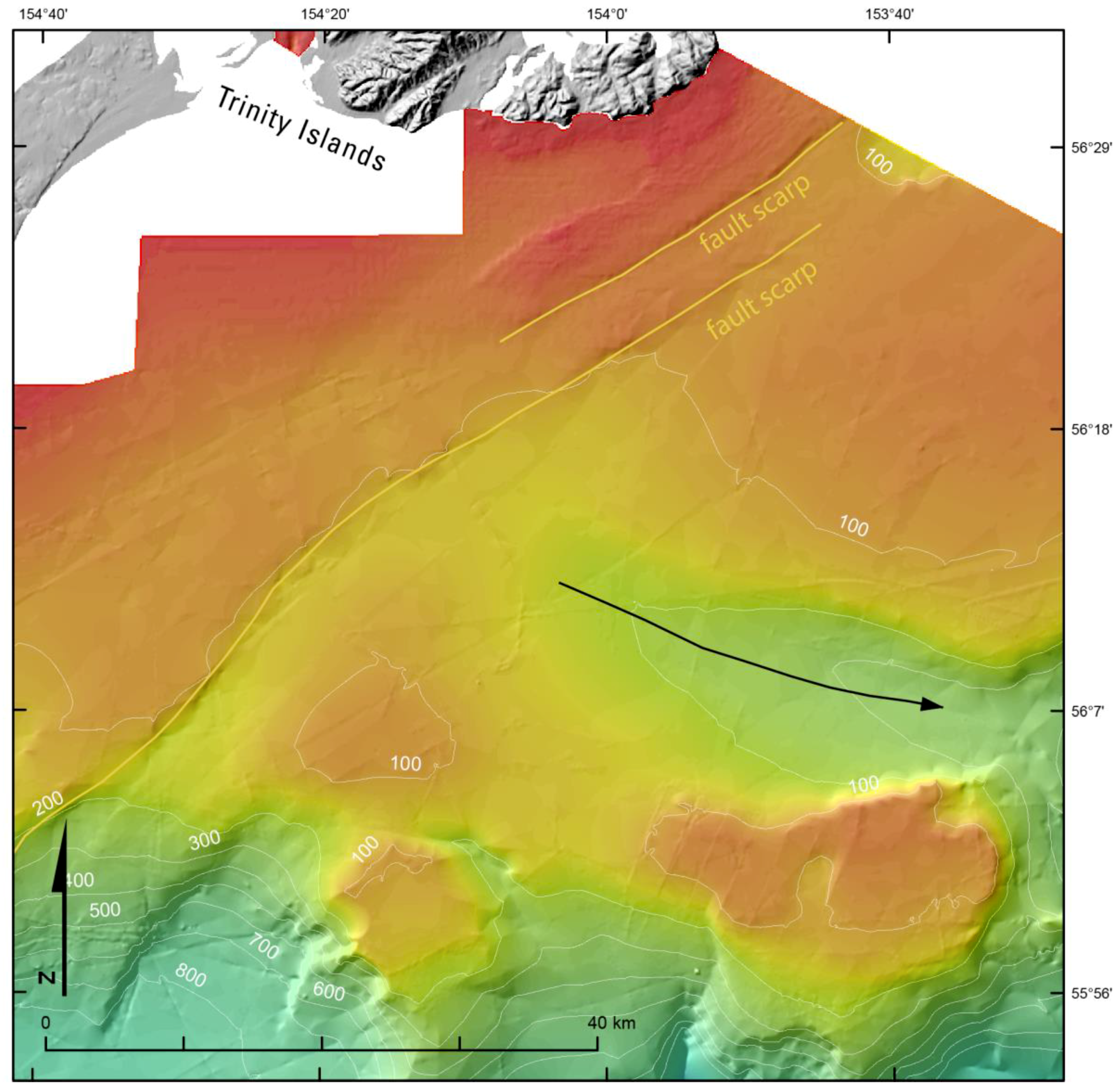
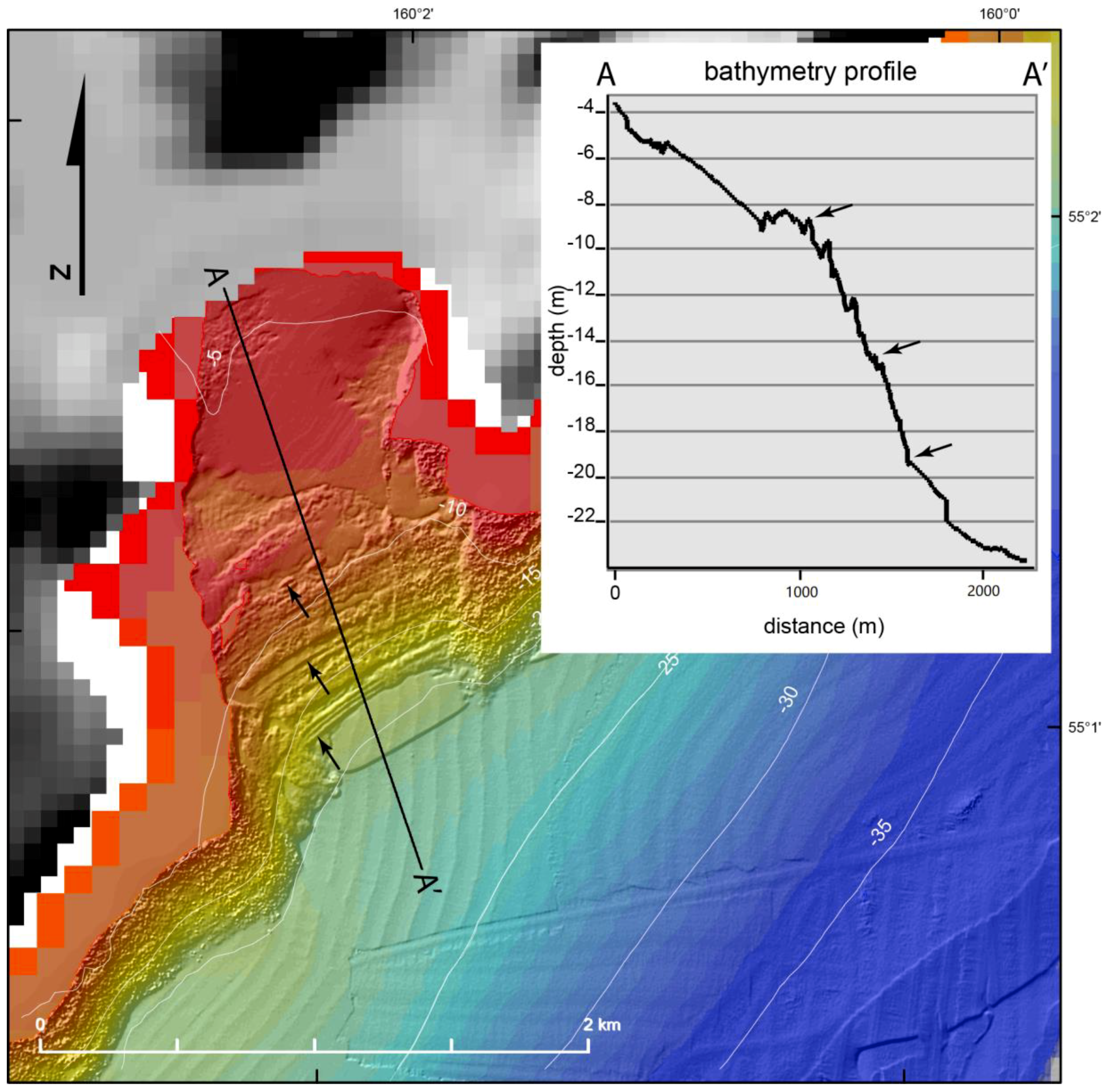
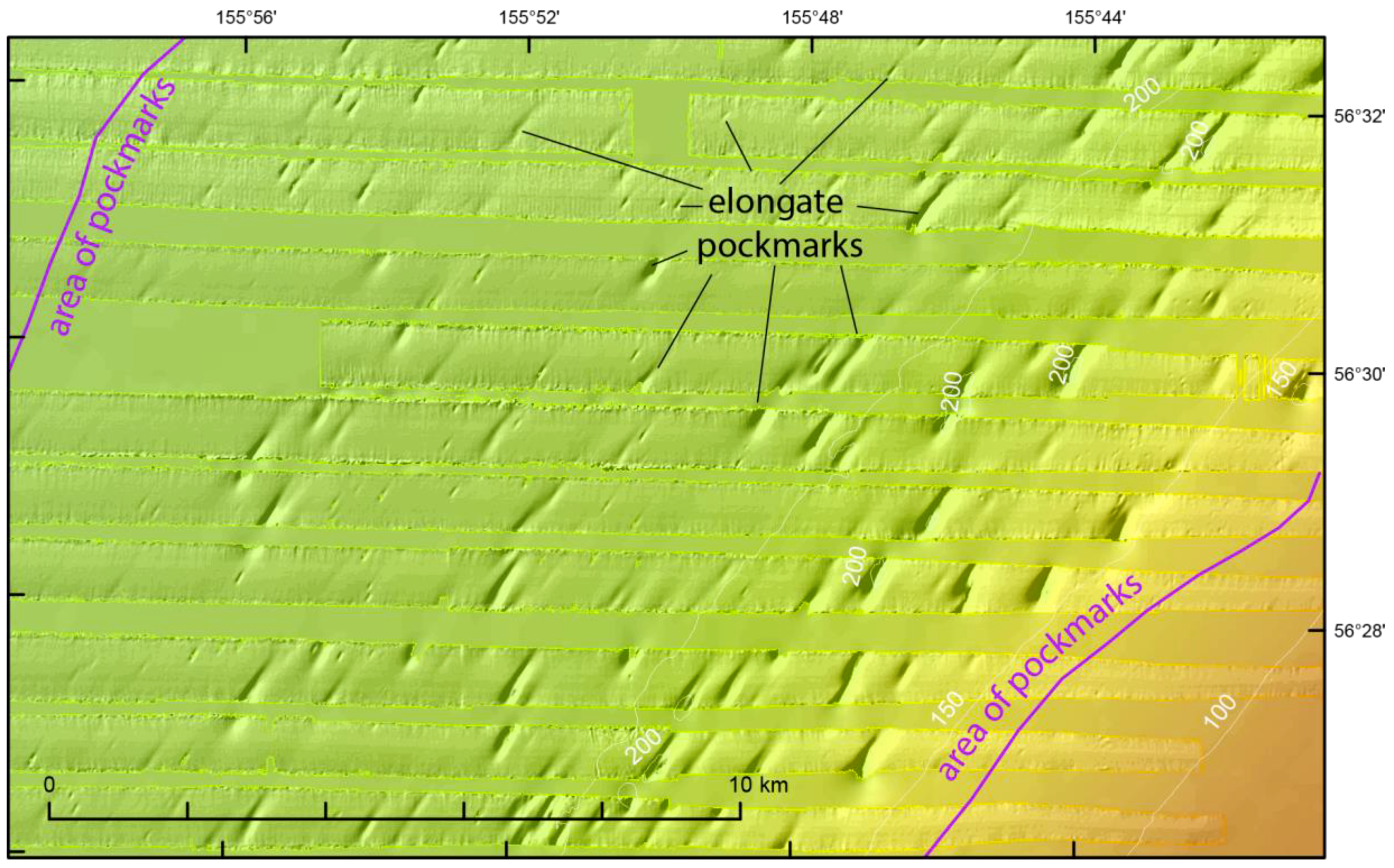
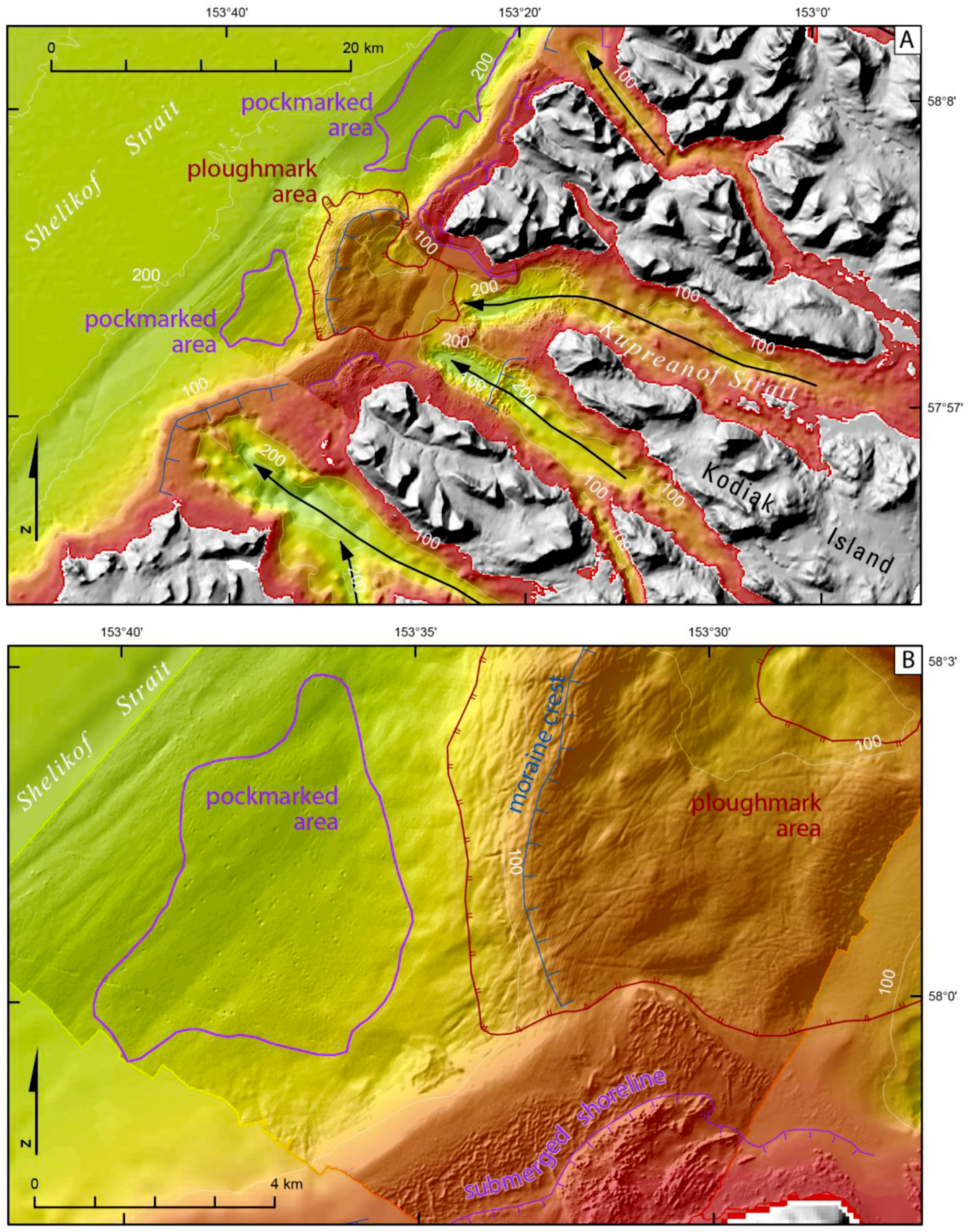
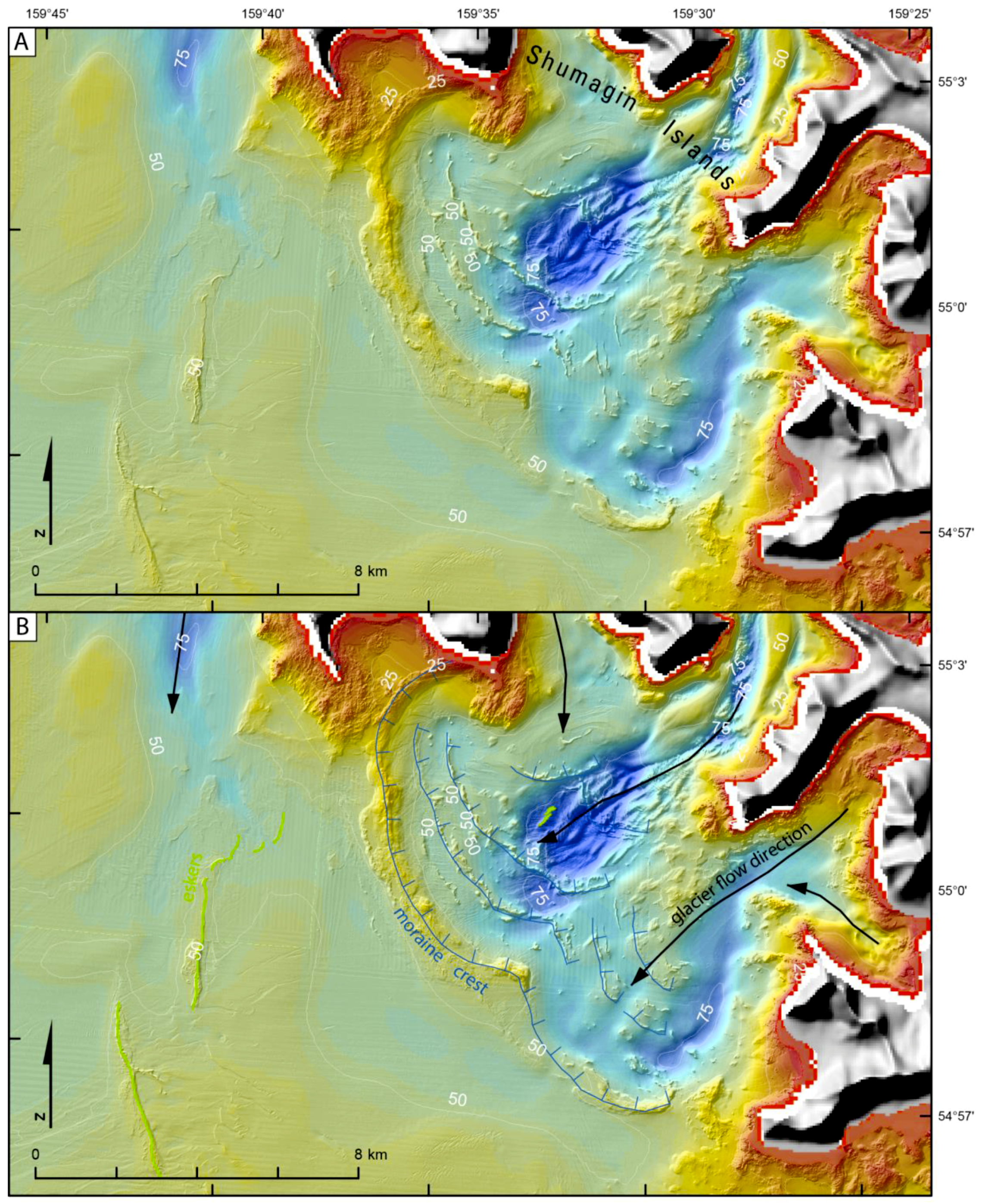
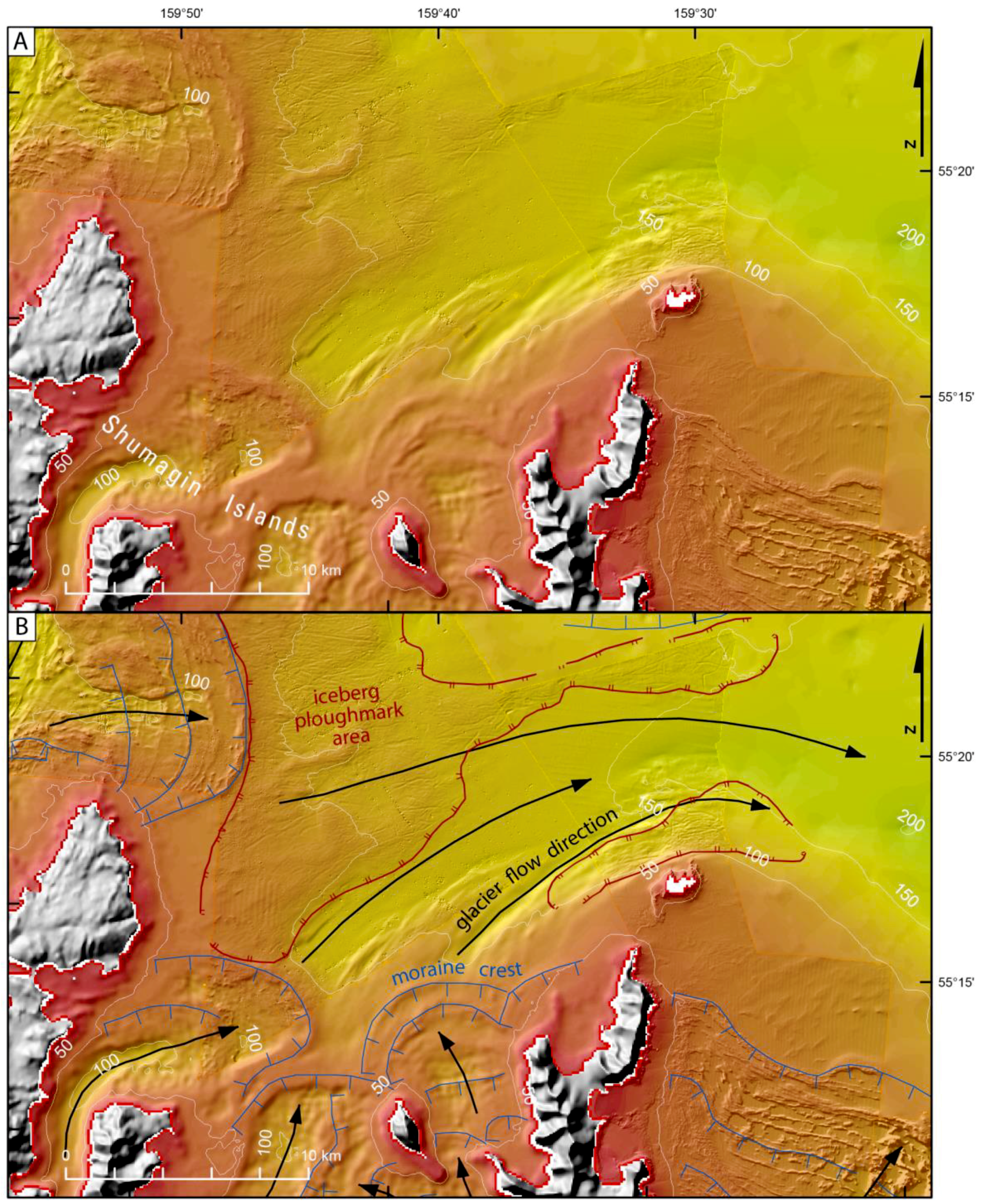
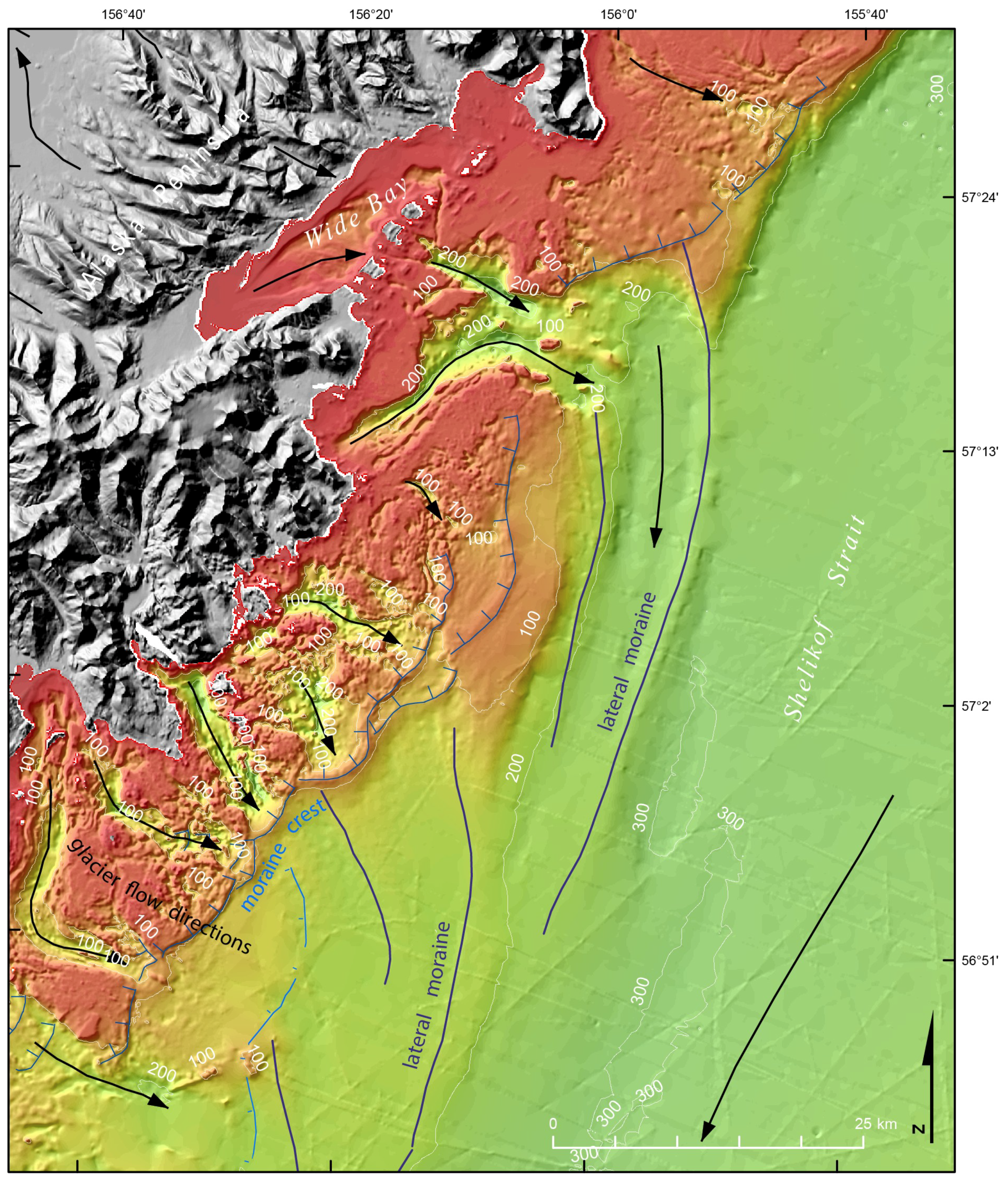
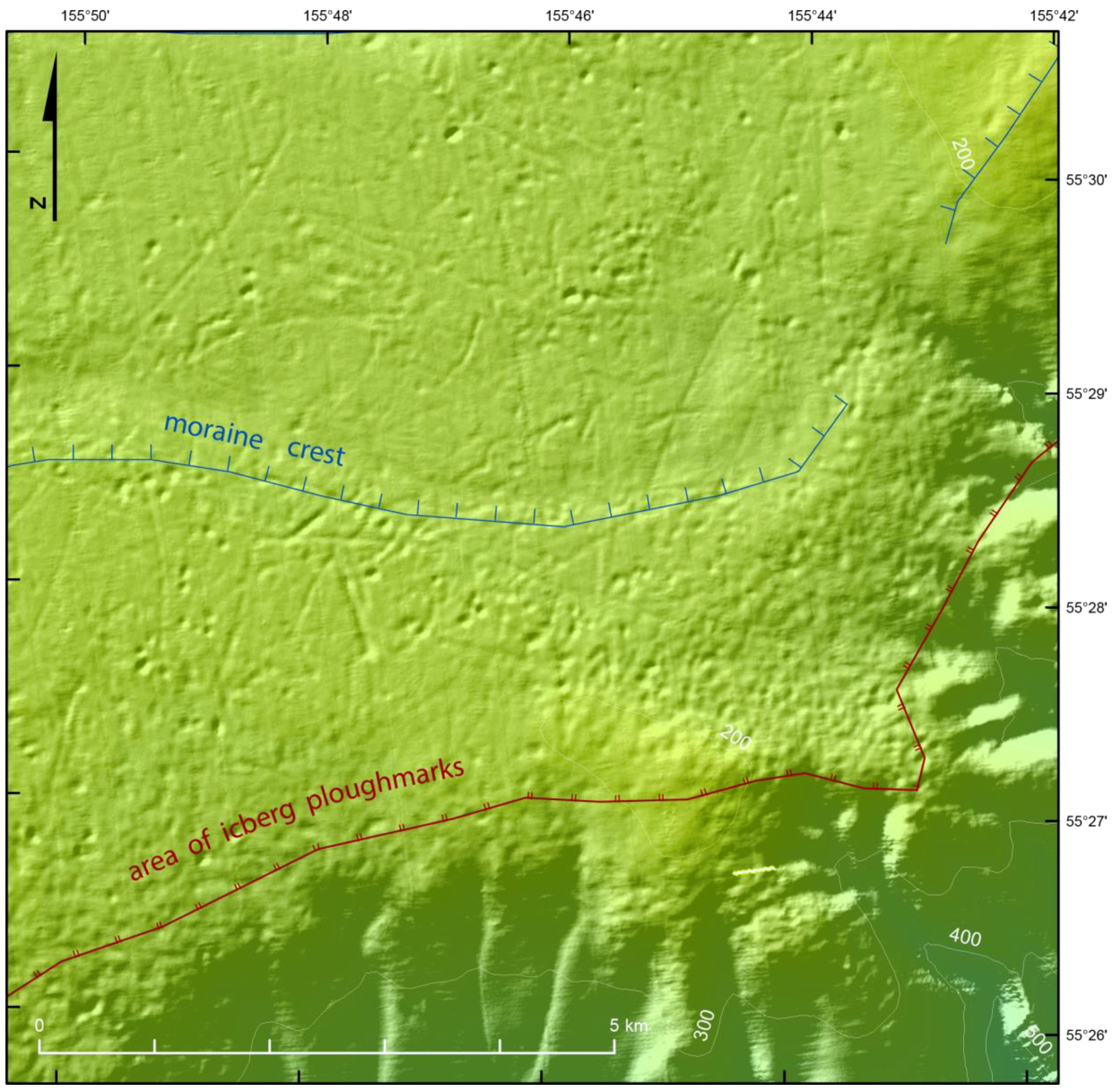
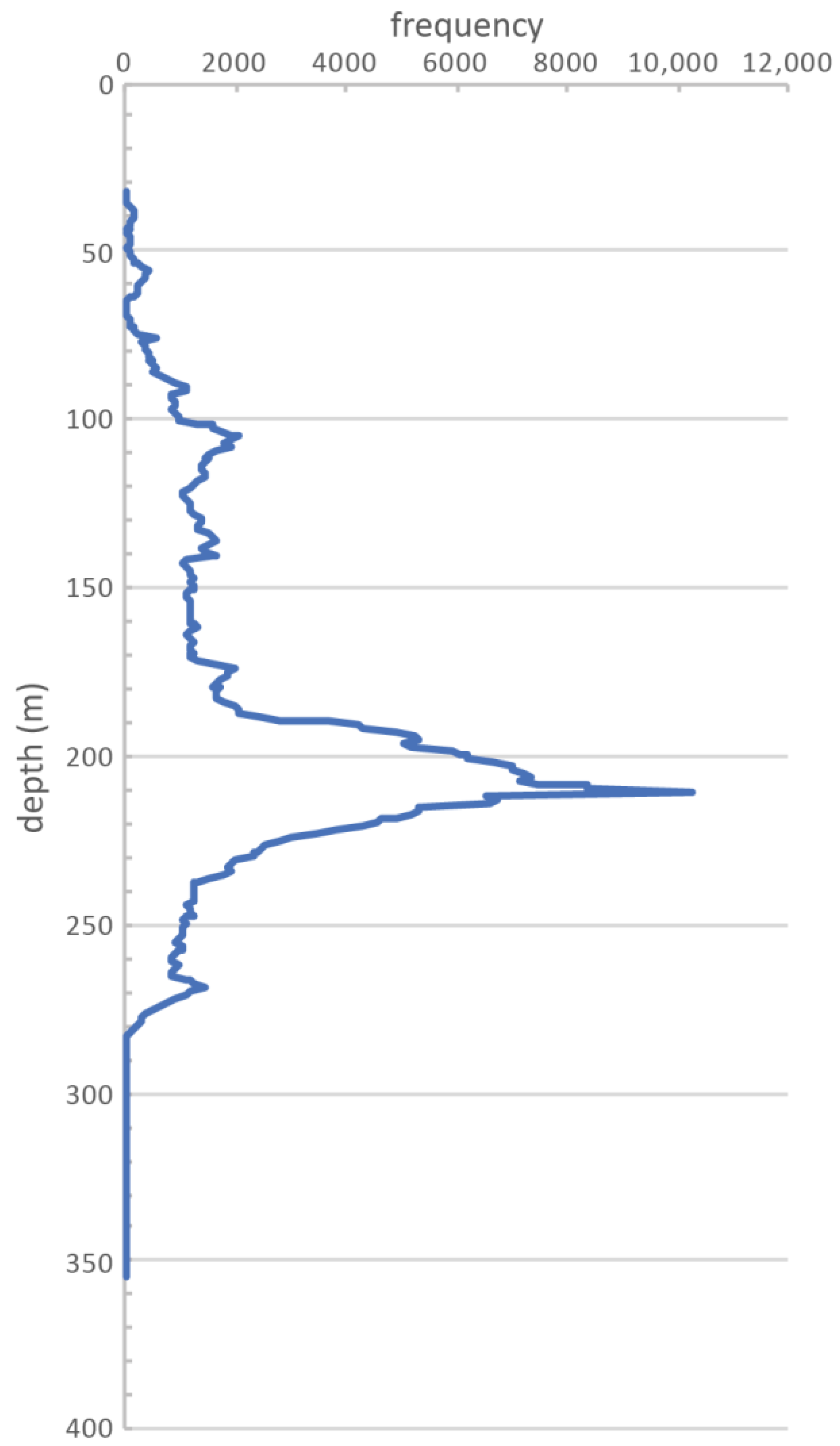
| Type | Area | Year Start | Year End | Number of Cruises | Soundings (n) |
|---|---|---|---|---|---|
| Smooth sheets | AI edge | 1936 | 1938 | 7 | 72,000 |
| CI edge | 1965 | 1983 | 4 | 33,000 | |
| CGOA edge | 1907 | 1981 | 14 | 125,000 | |
| Western Peninsula | 1913 | 1954 | 82 | 563,000 | |
| Central Peninsula | 1925 | 1997 | 73 | 1,384,000 | |
| Shelikof Strait | 1906 | 2000 | 88 | 475,000 | |
| Offshore (Deep) | 1961 | 1961 | 2 | 1000 | |
| Multibeam | Onshore (Shallow) | 2001 | 2015 | 158 | 2,599,000 |
| Offshore (Deep) | 1984 | 2009 | 9 | 3,348,000 | |
| Non-hydrographic | Outer Shelf | 1976 | 2017 | 40 | 9,113,000 |
| All types | All areas | 1907 | 2017 | 477 | 17,713,000 |
| Peninsula Location | Kodiak Location | Length (km) | Area (km2) | Average Depth (m) |
|---|---|---|---|---|
| Cape Douglas | near Wonder Bay | 45.971 | 6.504 | 141.5 |
| Cape Ugyak | Cape Raspberry | 46.723 | 8.931 | 191.2 |
| Cape Kuliak | Cape Ugat | 36.434 | 7.275 | 199.7 |
| Cape Atushagvik | Cape Ugat | 36.342 | 7.286 | 200.5 |
| Cape Igvak | Cape Ikolik | 75.815 | 14.984 | 197.6 |
| Passage Name | Length (km) | Area (km2) | Average Depth (m) |
|---|---|---|---|
| Kupreanof Strait | |||
| Whale Passage | 1.131 | 0.023 | 19.9 |
| Afognak Strait | 1.200 | 0.013 | 10.9 |
| Raspberry Strait | |||
| The Slough | <0.001 | <0.001 | NA |
| The Narrows | <0.001 | <0.001 | 0.5 |
| Shuyak Strait | |||
| Cape Current Narrows | 0.500 | 0.008 | 15.7 |
© 2019 by the author. Licensee MDPI, Basel, Switzerland. This article is an open access article distributed under the terms and conditions of the Creative Commons Attribution (CC BY) license (http://creativecommons.org/licenses/by/4.0/).
Share and Cite
Zimmermann, M.; Prescott, M.M.; Haeussler, P.J. Bathymetry and Geomorphology of Shelikof Strait and the Western Gulf of Alaska. Geosciences 2019, 9, 409. https://doi.org/10.3390/geosciences9100409
Zimmermann M, Prescott MM, Haeussler PJ. Bathymetry and Geomorphology of Shelikof Strait and the Western Gulf of Alaska. Geosciences. 2019; 9(10):409. https://doi.org/10.3390/geosciences9100409
Chicago/Turabian StyleZimmermann, Mark, Megan M. Prescott, and Peter J. Haeussler. 2019. "Bathymetry and Geomorphology of Shelikof Strait and the Western Gulf of Alaska" Geosciences 9, no. 10: 409. https://doi.org/10.3390/geosciences9100409
APA StyleZimmermann, M., Prescott, M. M., & Haeussler, P. J. (2019). Bathymetry and Geomorphology of Shelikof Strait and the Western Gulf of Alaska. Geosciences, 9(10), 409. https://doi.org/10.3390/geosciences9100409




